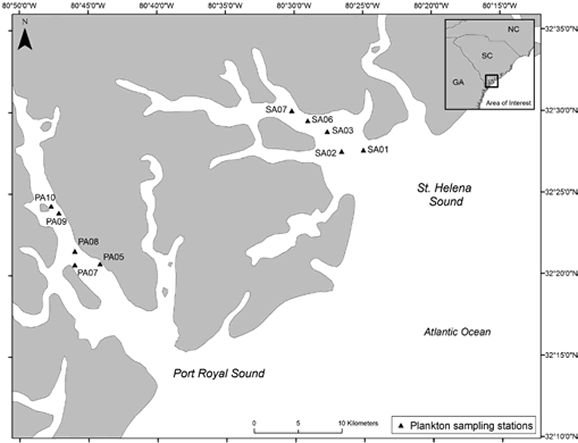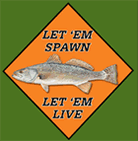Are Cobia Spawning Inshore in South Carolina?
Cobia have a complex life history and, until recently, little was known about their reproductive habits. Cobia were once thought by some to be a migratory species of fish that only spawn offshore in deep water and spend their entire life in the open ocean. Biologists have collected eggs in the Gulf Stream off North Carolina, which suggested spawning took place somewhere offshore. Other researchers in Virginia believed that inshore spawning of cobia may occur in the lower regions of Chesapeake Bay, based on the collection of eggs immediately south of the bay and the ovarian condition of females collected in the bay. In South Carolina, local recreational anglers and charter boat captains have known for years that large egg-laden female cobia move into the inshore waters of St. Helena Sound (SHS) and Port Royal Sound (PRS) in large numbers, presumably to spawn. This recreational cobia fishery usually runs from April to June when water temperatures approach 68-70 degrees Fahrenheit inside the estuary. April through June also corresponds to the highest fishing effort in the region, as evidenced by the increased landings during these months because cobia are much more accessible to anglers.
Beyond the general knowledge of spawning season, very little information exists on spawning habitat and time of day of cobia spawning because much of the previous research has focused on age and growth, feeding habits and general reproductive biology.
The main goal of our study was to determine if cobia actually spawn in PRS and SHS or might just be feeding on schools of baitfish before moving into deep water to spawn.
SCDNR biologists collected cobia in a few different ways. They collected carcasses provided by recreational anglers and cooperating charter boat captains through our freezer program as well as attended every cobia tournament held in the southern part of the state between 2007 and 2012. Date, time, and location of capture were noted when available, with fish collected within PRS and SHS designated as “inshore” and fish collected outside the two estuaries (defined as outside the barrier islands) designated as “offshore”.
Table 1. Stage of egg maturation in female cobia collected in inshore and offshore waters in South Carolina, 2007-2008.
| Maturity Stage | Cobia caught inshore (%) | Cobia caught offshore (%) |
|---|---|---|
| Immature | 0 | 0 |
| Developing | 2 | 3 |
| Late developing | 80 | 59 |
| Actively spawning | 3 | 0 |
| Recently Spawned | 5 | 3 |
| Previously spawned | 11 | 32 |
| Regressing | 0 | 3 |
When fish were entered in a tournament to be weighed, biologists removed ovaries of the females and brought them back to the laboratory to determine the level of maturity by carefully evaluating the egg stages inside the ovary. Cobia are what are called “batch spawners,” meaning that they will spawn several times during the spawning season. By evaluating how mature or “ripe” the eggs are, biologists can determine whether the fish were likely to spawn or had previously spawned even within a few hours. Results showed that 80% of the fish collected inshore were in spawning condition and preparing to spawn, 3% were actively spawning and 16% had recently or previously spawned. The fish collected offshore also showed similar trends with almost 60% ready to spawn and 35% recently or previously spawned (table 1). What we were unsure of was whether the cobia found within SHS and PRS left the estuary to spawn in offshore waters. If fish were actively spawning within both SHS and PRS, then we would expect to find recently spawned eggs and larval cobia somewhere in the estuary. In order to prove this we set several fine mesh plankton nets to collect eggs and small larvae every week between April and June in 5 locations in Port Royal Sound and 5 locations in St. Helena Sound (fig. 1).

As we expected, we found cobia eggs and larval cobia in every sample in May and June. We were also able to age the eggs to within an hour of being spawned by comparing the eggs’ development to eggs produced in the laboratory for stock enhancement. Eggs develop at a rate governed by the temperature of the water. Using cultured cobia allowed us to better understand what was occurring in the wild. We found that some eggs collected far up the Broad River in Port Royal Sound were only a few hours old. These eggs must have been spawned in the estuary because they could not have traveled from offshore in such a short period of time. These findings have proven that cobia enter the estuary and spawn. These two estuaries provide the only verified inshore spawning grounds for cobia on the East Coast, making them extremely important and unique systems that may warrant special protection.
These findings, supported by the genetic findings that these are distinct population segments, mean that if this part of the population is overfished that cobia from another area will not take their place. Due to the potential for heavy exploitation by recreational anglers as cobia move inshore to spawn in South Carolina, current management strategies may need to be re-evaluated.



